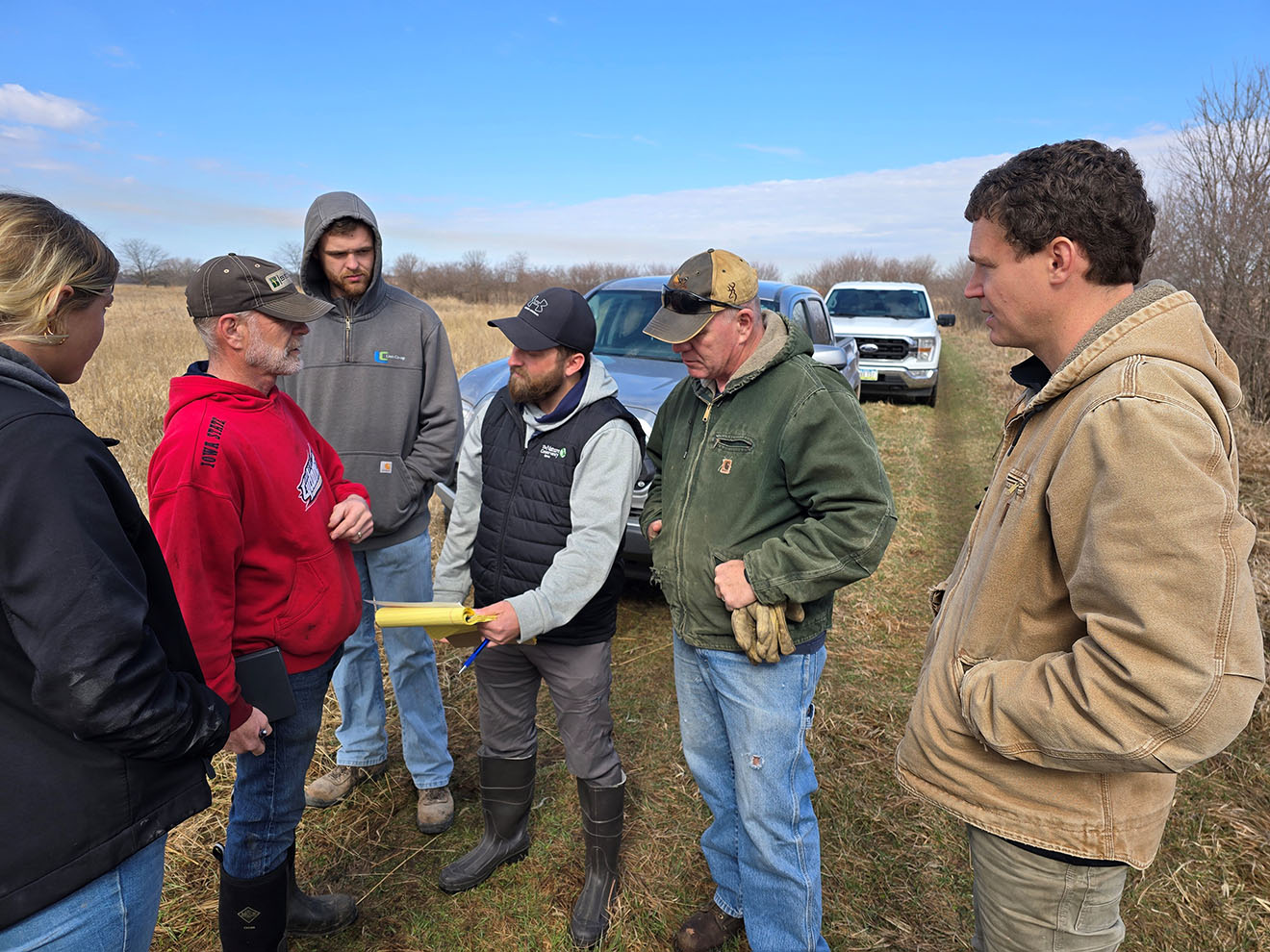
Steve and Mark Brecht meet with Iowa Soybean Association (ISA) Conservation Agronomist Evan Brehm and The Nature Conservancy in Iowa’s Andrew Rust about the possibility of restoring oxbows on their property. (Photo credit: Jeff Hutton/Iowa Soybean Association)
Making conservation count
March 27, 2025 | Jeff Hutton
Conservation was top of mind for two sets of farmers in eastern Iowa this week.
From oxbow restoration to a firm commitment to no-till and cover crops, Benton County may be home to what’s possible in farming and protecting the environment.
Oxbow options
For brothers Steve and Mark Brecht of rural Norway, the future is water – protecting it and facilitating its use.
“We’re hoping we can install them here,” says Steve, pointing to an area, now covered in some switchgrass and scrub grass and often impacted by flooding from nearby Prairie Creek, which flows into the Cedar River and the city of Cedar Rapids.
Steve, whose operation includes soybeans, corn and hay ground for his cow-calf operation, already plants on the contour as well as perpendicular to the water flow.
But occasional flooding as well as a desire to be more protective of water resources that flow downstream have both Steve and Mark seeking help.
On this day, the brothers met with Iowa Soybean Association (ISA) Conservation Agronomist Evan Brehm and The Nature Conservancy in Iowa’s Andrew Rust about the possibility of restoring oxbows on their property.
Oxbows are winding, meandering disconnected pools – very often a common sight across the Iowa landscape. Over time, however, some waterways become filled with sediment carried in from the mainstream. Restoring oxbows can offer a wide range of benefits, from providing an ecosystem for endangered wildlife; to the preventative, helping to remove nitrates before heading for a waterway; and even flood control.
Rust, a freshwater restoration specialist with the conservancy, walked the property with the Brechts, said their property could very well be the right opportunity for oxbow restoration.
“We work with landowners, visit the site and make sure we have access for the contractors,” he says.
Aerial imagery, maps and measurements during this week’s visit were good indicators that the Brecht property might be approved.
“It’s all about aligning goals with the landowners,” Rust says, adding that once approved, the process could take upwards of six months to a year.
Most of that time is devoted to permitting and paperwork, through the Iowa Department of Natural Resources, the Army Corps of Engineers and other entities.
The actual digging out of an oxbow is usually just a few days to a few weeks.
For Mark Brecht, the opportunity to help his property flourish, while protecting water resources downstream, is one he and his brother don’t want to pass up.
“I just think it’s too important,” he says.
A testament to no-till and cover crops
Just a handful of miles west of the Brecht farm is rural Watkins – home of the Manternach family farm where they raise soybeans, corn and cattle.
Dave Manternach and his father, Steve, are good examples of how conservation practices can benefit their bottom line and the environment.
“You know, my dad has been doing no-till for probably 40 years now – 100% for corn and soybeans,” says Dave. “We have neighbors, who will come over and say that our corn stand is better, our root balls are a little more surefooted, while they have looser soil from the tillage.”
For Dave, no till is just one area of conservation.
The Manternachs are big proponents of implementing cover crops.
“Before there was funding, we knew cover crops were the right thing to do,” Dave says. “Over the yards, we’ve tried oats, rye - different combinations.”
Heavy on cereal rye in recent years, Dave and Steve tried seeding with an airplane and drones. Thus far, they’ve had the best luck with a 15-inch row planter directly into the soil.
“We’re always willing to try new things, trying to figure out the next step,” Dave says.
With no-till and cover crops, the Manternachs believe their efforts are catching on with others who see the benefits, including those with livestock being able to graze those fields.
But whether they were fully implementing conservation practices or not, Dave says adaptation is critical, since nothing is ever predictable when it comes to farming.
Brehm says Steve Manternach was one of the first farmers in the Benton and Linn County area to facilitate conservation practices like cover crops and no-till. The results, he says, are evident that conservation works.
“I think guys are warming up to the concept more and more,” he says.
“We’ve found we have had really good luck with it,” says Dave. “We’re willing to try a lot of stuff to see if it works.”
Dave says he appreciates what ISA, Linn Coop and others, provide him and his father, as far as information and guidance on what’s possible in their farm fields.
“It’s good to get that information and advice to see what else is going on,” he says. “And I feel like our yields have gone up because of it.”
“Dave and Steve are always looking at innovative ideas and products and willing to try new things,” Brehm says. “There’s ground truth in what they’re doing.”
Back